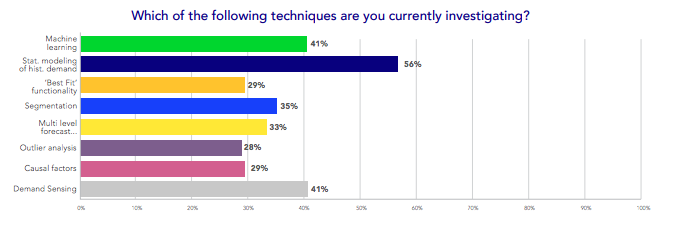New AIMMS Survey Shows that Organizations are Betting on New Technologies to Improve Forecast Accuracy
Bellevue, Washington, February 12, 2020 – In today’s volatile and uncertain world, improving demand forecasting is at the top of the agenda, shows a report recently published by AIMMS. A combined 61% of research participants indicated that improving forecast accuracy is either “important” or “extremely important” for their organizations. To improve accuracy, many are betting on new technologies like machine learning and demand sensing.

AIMMS surveyed more than 300 professionals working in supply chain, finance, sales and commercial/trading roles. Respondents operate across several regions, including North America, Europe, Latin America and Asia Pacific. Various industries are represented in the research, ranging from chemicals to consumer electronics, food and beverage, and manufacturing.
Perceptions on Forecast Accuracy
Demand forecasting is seen as a crucial part of the business planning process. Yet, only 2% of respondents reported being “extremely satisfied” with the accuracy of their forecasts. The typical range of absolute forecast error at an item level is reportedly 20-40% according to 42% of respondents.
Technologies and Techniques in Use
Technology may play a role in organizations’ perceptions of forecast accuracy. Only 2% of respondents stated that they were “extremely satisfied” with the tools they use for demand forecasting. Neutrality appears to be the norm, with 49% of respondents rating their satisfaction with their current technology between a 5 and a 7. Roughly 27% are not satisfied.

39% of respondents stated that they use spreadsheets for demand forecasting. Nearly 45% of those who use spreadsheets are dissatisfied, showing that this toolset is not robust enough. 30% of respondents stated that they use a specialist forecasting package, and 61% them reported being satisfied. Nearly a quarter of respondents (23%) use bundled ERP functionality, and the majority feel indifferent about this toolset.

The research shows that organizations are looking into several techniques to improve demand forecasting. 56% of professionals are looking into statistical modeling of historical demand at their organizations, and 41% are looking into machine learning. Another 41% is currently investigating demand sensing. Other techniques that are being investigating include ‘best fit’ functionality and segmentation. 60% of respondents also indicated that they were “somewhat” to “extremely curious” about new techniques like DDMRP to decouple execution from the impacts of forecast accuracy.

“With ongoing challenges, like coping with seasonality, and geo-political shifts on the horizon, it’s not surprising to see that organizations are looking into new techniques and technologies for demand forecasting. The use of machine learning holds a lot of promise to help organizations skip a lot of the manual work involved and focus on the trends and outliers that stand out. Pursuing accuracy in long–term planning brings a lot of unnecessary stress, so it may also be time to also consider a more resilient approach.”
– Brian Dooley, SC Navigator Director at AIMMS
For more insights, download a copy of the report.
About AIMMS
AIMMS is a forward-thinking software platform provider democratizing the use of prescriptive analytics so that functional users have the power to make better decisions.





